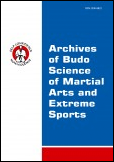2018, Volume 14, Issue 1
The knee joint extensor and flexor strength indicators in judo female athletes
Kazimierz Witkowski1, Paweł Piepiora1, Monika Grochola1
1Faculty of Sports Sciences, University of Physical Education in Wrocław, Wrocław, Poland
Author for correspondence: Paweł Piepiora; Faculty of Sports Sciences, University of Physical Education in Wrocław, Wrocław, Poland; email: pawel.piepiora[at]awf.wroc.pl
Full text
Abstract
Background & Study Aim: Muscle strength, namely the capacity for overcoming the external resistance or counteracting it at the expense of muscular effort, plays an unquestionably essential role in judo competitor's training. The objective of this study has been knowledge about the values of torques, torque gradient and muscle strength deficit released by knee joint extensors and flexors at rest by judo female competitors, taking up specialist strength training.
Material & Methods: Two female study groups were selected: judo female competitors (n = 15); aged 22.20 ±1.32 years, body weight 67.47 ±13.58 kg, competitor seniority 11 ±1.60 years; reference sample (n = 15) non-full-time in any sports discipline female students of the University of Physical Education (AWF) in Wrocław, Poland: aged 22.20 ±1.26 years, body weight 64.33 ±8.25 kg. A study of knee joint extensors and flexors torque was performed at rest. The measurement was made at 30 and 70 degrees. The properties of a lever in equilibrium were applied: 1) sum of torques acting on a lever equals zero; 2) sum of forces acting on a lever equals zero.
Results: Judo female competitors generate: higher values of torques of both right and left knee joint extensors and flexors at 30°; higher values of torques of both right and left knee joint extensors at 75°; higher mean value of torque gradient of knee joint extensors and flexors at 30 degrees; higher mean value of torque gradient of knee joint extensors and flexors at 75 degrees.
Conclusions: Due to higher maximum values of torque and the torque values being generated within a shorter time than the AWF female students, the competitors show a greater capacity of the muscle for developing higher strength values and a greater capacity for a fast release of strength. The difference must be conditioned by many years of adaptation of the muscle and nervous systems to the effects of sports training as well as a specific nature of that sports discipline; the dynamics of releasing muscle strength, to some extent, determines the speed of performing an action and its effectiveness.
Key words: muscle strength, flexor muscles, deficit value, strength training, tokui waza





